| Project Title/ID Number |
Performance Evaluation
of Gypsum Wallboard Partitions—5322003 |
| Start/End Dates |
10/1/03—9/30/04 |
| Project Leader |
José Restrepo (UCSD/F) |
| Team Members |
Anna Lang (UCSD/GS) |
F=faculty; GS=graduate student; US=undergraduate student; PD=post-doc; I=industrial
collaborator; O=other
Click on images to enlarge in a new window
1. Project Goals/Objectives:
This project will continue to continue to develop data and models to characterize
the performance of gypsum wallboard partitions under imposed drifts, of
the type common to modern office, hotel, and laboratory buildings.
2.
Role of this project in supporting PEER’s mission
(vision):
Fragility models obtained from experimental work will be used to calibrate
loss estimation models by other PEER researchers. Apart from the direct
usefulness of the resulting fragility models for architectural partitions,
this investigation will serve as a model (or best practice) of how to
apply the PEER-PBEE methodology to evaluate Engineering demand parameter
(DP) to Damage Measures (DM).
3. Methodology Employed:
Quasi-static reversed loading experimental work.
4. Brief Description of past year’s accomplishments
(Year 6) & more detail on expected Year 7 accomplishments:
Year 6: The objectives of Year 6 project were to develop data and models
to characterize the performance of gypsum wallboard partitions, of the type
common to modern office, hotel, and laboratory buildings. The primary variables
and parameters to be addressed were wall configuration (aspect ratio, openings,
etc), boundary and support conditions, performance damage states, and loading
protocol. The investigation will culminate in the development of parametric
fragility models relating EDPs, such as interstory drift, to various DMs,
such as cracking pattern, which take into account appropriate sources of
uncertainties in the response. Sixteen gypsum wallboard partitions were
tested. The main variables studied were wall configuration (aspect ratio,
openings, etc), boundary and support conditions. The wallboards were screwed
to steel studs using standard practice. Experimental work was designed in
support from an Industry Advisory Board. All tests were extensively instrumented.
Damage states were obtained from each of the tests. A database complemented
with pictures will be made available.
Figure 1 shows the typical wall configurations
tested. The first configuration included a steel doorframe typically found
in office buildings. The second
configuration was a solid wall. Other configurations included gypsum wallboards
of partial height, commonly used when no fireproof requirements dictate
as well as wallboards attached to heavy steel studs.
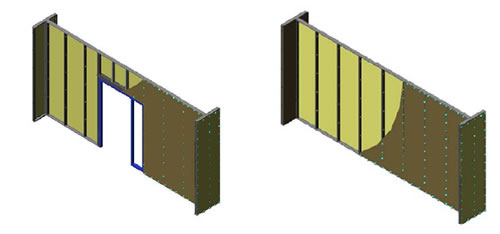
Figure 1. Examples of wallboard partition units tested
Testing was conducted to identify the development of the following damage
states:
-
DS1 – Minor damage fixed by mud and
-
DS2 – Sections of wallboard
need replacing
-
DS3 - Framing needs to be replaced
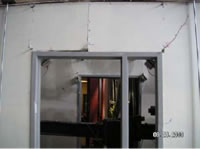 |
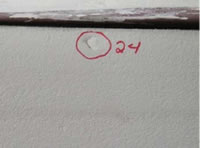 |
| (a) Wallboard and joint cracking |
(b) Screw head popping |
Figure 2. Examples of damage state DS1
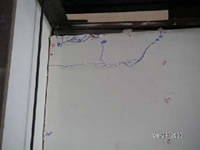 |
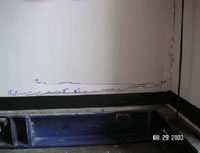 |
| (a) Partial wallboard separation |
(b) Buckling of wallboard |
Figure 3. Examples of damage state DS2
Damage state DS1 was observed when the screws head popped out, when minor
cracking developed in the wallboards, and when incipient buckling was observed
in the baseboard. Figure 2 shows examples of DS2. Damage State DS2 was
observed when large wallboard pieces broke away and when large ridges developed
in the wallboards. Examples of DS2 are depicted in Figure 3.
 |
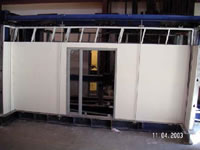 |
| (a) Internal steel stud buckling |
(b) Exterior steel stud buckling |
Figure 4. Examples of damage state DS3
The final damage state, DS3, required the entire replacement of the wallboard
and steel studs. Figure 4 shows examples of DS3. The damage states were
correlated to the imposed interstory drift. Figure 5 plots the development
of the damage states with drift.

Figure 5. Examples of damage state DS3
Year 7: Two units will be built with wallboards on the four sides, thus
representing an actual office environment. The units will be tested under
bi-directional loading during summer of 2004. These tests are aimed at
observing the effect of bi-directional loading on the development of the
Damage states. Figure 6 shows a rendering of a test unit.
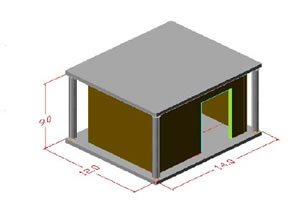
Figure 6. Rendering of a Test Unit for Year 7
5. Other Similar Work Being Conducted Within and Outside
PEER and How This Project Differs:
6. Plans for Year 8 if project is expected to be continued:
Experimental work aimed at improving connection details to delay the development
of the damage states in gypsum partition walls.
7. Describe any actual instances where you are aware your
results have been used in industry:
Unknown.
8. Expected Milestones & Deliverables:
This project is envisioned as the final year of a two-year effort that
will entail close coordination with other PEER researchers and a small
group of experts to advise on the investigation.
Major deliverables will
be:
-
A methodology for developing the fragility
models through combined testing and statistical modeling,
-
An archived
database of wall performance data, compiled in an electronic database
made accessible to other researchers and engineering professionals,
-
A set of parametric fragility functions relating EDP-DM for partition
walls.
Major milestones are as follows:
-
January 2004 – Have an electronic
database in place for archiving wall test data and processing relevant
statistics.
-
March 2004 - Refine and reconfirm detailed plans for final
series of wall tests with input from advisory committee.
-
May 2004 – Commence
final series of wall tests
-
October 2004 – Finalize project
report and archival of database of performance-data and models.








